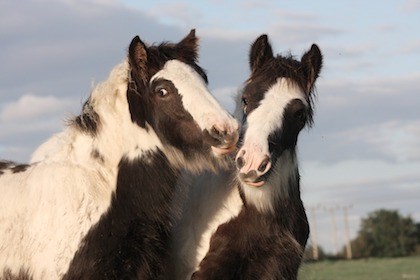|
This article has appeared previously with Equestrian Life. To see what's in our latest, free digital issue, click here.

When should I worm my foal and what should I use?
BY DR MAXINE BRAIN
FOALS, LIKE OTHER young animals, are very susceptible to the damaging effects of parasites. Heavy worm infestations can lead to many important health problems, including diarrhoea, colic, anaemia, ill thrift and poor or reduced growth rates. The main route of infestation for the foal is oral, with foals ingesting parasites or parasite eggs from the mare’s milk, her faeces and the environment. Infestation can also occur via skin penetration by the larval forms of some worms.
There are four major parasites of concern in foals – strongyloides, ascarids, large strongyles and cyathostomes. As the foal ages other parasites also become important, but for this article we shall concentrate on the younger foal. Two of the major parasites affecting foals, strongyloides and ascarids, are much less of a problem in adult horses because immunity to these worms develops as the horse ages. However, in young foals they can have quite devastating effects, which is why it is important they are addressed.
Strongyloides (threadworms) – Mares can harbour adult strongyloides worms in their intestine. Around the time of foaling these worms produce larvae (the immature form of the worm), which make their way into the mare’s milk and are ingested by the foal. This typically happens within a few days of birth (about day four) and continues for many weeks. The mare can also pass the larvae and eggs in her faeces, the foal can be infested either by eating the mare’s faeces (which is a normal event with foals) or via skin penetration. Larvae burrow through the skin and can move via the bloodstream to the lungs where they are coughed up and swallowed back into the gastrointestinal tract where they mature to adult threadworms.
Parascaris equorum (ascarids, large roundworms) – Eggs are ingested from contaminated pastures. Following ingestion, the eggs hatch to produce larvae, which migrate via the bloodstream to the liver and from there to the lungs. As with the strongyloides, the larvae in the lungs are coughed up and swallowed, setting up adult worm burdens in the intestines. As well as the damage the parasites cause in the gut, there can also be damage caused to the liver and lungs as they track through these organs.
Cyathostomes (small strongyles) – Eggs are ingested off the pasture (via faecal contamination). These develop within the intestine into immature larvae, which burrow into the walls of the intestines, causing blood-filled nodules along the gut. As the larvae mature into adults, they emerge from the gut wall causing tissue damage and bleeding as they erupt. The mature adult worms then attach to the gut wall, sucking blood and producing ulcers.
Large strongyles (red worms) – These are parasites, which are important throughout the horse’s entire life. They have been included here because their migration through the body during the earlier stages of the foal’s life can result in some very serious health issues later on in life. As with other parasites, the eggs are ingested and the larvae develop in the intestines, but what makes these worms particularly bad is that the larvae penetrate through the gut and migrate throughout the body via the walls of blood vessels. The larvae can then end up in many vital organs of the body, including the brain, the heart, the lungs, liver and major blood vessels. When the larvae emerge from the walls of these vessels they can cause major damage to these organs which can result in the death of the horse. Even though the life cycle of these worms is six to seven months – and so the worms are not always seen in the younger foal – it is important that they are taken into consideration when discussing worming protocols in foals.
Treatment
Unfortunately there is no simple, one-wormer solution to treating foals. Some of the anthelmintics (worming medications) are very good for one type of worm but less effective for another type. Many of the wormers available today are ivermectin-based, which are usually very good but have very little effect against the ascarids. Fenbendazol (FBZ) has a very good effectiveness against the ascarids but is ineffective against the strongyloides worms. Thus we need to use a combination of wormers to achieve the desired result.
1. Worm the mare regularly during pregnancy and at the time of foaling with an ivermectin-based product that will greatly reduce the number of strongyloides larvae in the milk and faeces of the mare.
2. Worm the foal at round six to eight weeks with either an FBZ product. Panacur [trade name] is a commonly used product, or a pyrantal product.
3. Continue to worm the foal at six-weekly intervals with FBZ or at four-weekly intervals with pyrantal. Once the foal is 4-5 months of age, worm it with an ivermectin-based product to combat the small and large strongyle worms. Whilst moxidectin is one of the most effective products available to control the encysted larvae of the cyathostome worms, its use in foals is debatable. Some vets do not recommend it be used in foals under six months of age; however, it has been marketed as being able to be used in foals at three months of age. Extreme care must be taken in young foals as an overdose of this product can cause a neurotoxicity resulting in tremors, ataxia (incoordination), coma and death.
4. From five months of age to 12 months, continue to rotate the use of an FBZ wormer with an ivermectin-based wormer every six to eight weeks.
5. Once the foal is 12 months old it should be treated regularly under an adult worming schedule.
6. Remember to either use a weight tape, or if you are lucky enough to have access to scales, weigh the foal, so that accurate dosing of foals occurs (too much can sometimes be toxic and not enough can be ineffective).
Management protocols
Aside from just worming mares and foals with a wormer, there are many other management tools that can be put into place to optimise horse health when it comes to worming.
1. Remove the manure from the environment. Ideally this should be done daily, although practically two or three times a week may be more achievable.
2. Rake or harrow paddocks to break up the faeces to allow the eggs to be exposed to the weather, especially the sunlight and the heat to help destroy the eggs and larvae.
3. Do not overstock paddocks or yards as this increases the number of eggs per unit of area, resulting in a higher intake of parasite eggs per mouthful of food. It also results in foals having to graze closer to the ground, making ingestion of eggs and larvae more probable.
4. Dispose of any bedding or manure thoughtfully. If manure is to be heaped up outside of the yards, ensure the heap is on the downside of the paddock to reduce the likelihood of rain washing eggs back down in to the paddock. Composting manure will help kill the eggs due to the high temperatures generated.
5. Use feeders that are off the ground to minimise foals sifting through the dirt in areas where there has been high usage and hence increased faecal contamination.
6. Consider conducting faecal egg counts on farms twice yearly to investigate the actual worm burdens on farm. This enables monitoring of the types of worms and the effectiveness of worm control programmes, including drug resistance.
7. Use of good farming practices, such as rotation of paddocks with non-equine species or resting paddocks to reduce the number of eggs available for ingestion.
Hopefully this answers many of the questions readers have about basic worming in foals!
READ THE LATEST NEWS ARTICLES HERE

|

